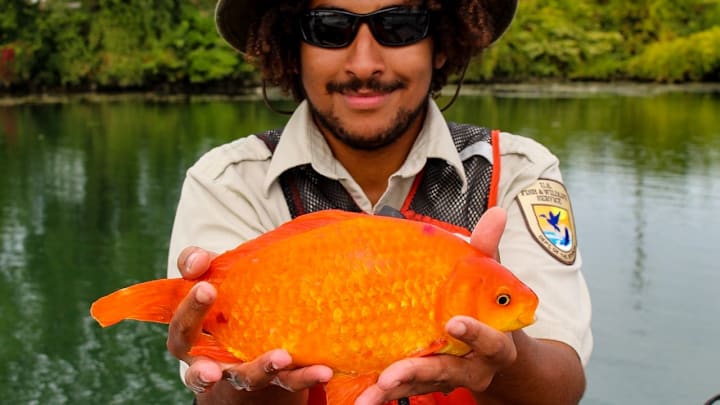At just a few inches in stature and subsisting on an affordable diet of flakes, goldfish are often viewed as the world’s most unobtrusive pet—a kind of gateway animal to prepare budding caregivers for cats and dogs to come. But their blank stare and slack-jawed expression belies a little-known and somewhat horrifying fact: Released into the wild and upping their calorie count, goldfish can develop into massive Mr. Olympia-sized fish, ravaging local ecosystems.
According to The New York Times, the Great Lakes are currently suffering from an influx of invasive goldfish. Devouring everything from algae to plants to invertebrates, the carp can reach 16 inches to 19 inches in length, with a bulbous torso weighing in at 4 pounds.
“They can eat anything and everything,” Christine Boston, an aquatic research biologist at Fisheries and Oceans Canada, told the Times.
But all that consumption is disruptive. The goldfish devour plants that native fish eat. They also consume algae, which promotes further algae growth. Because they’re resistant to fluctuating water temperatures, they can also be persistent nuisances. All this pillaging means native fish are being muscled out of their natural habitat.
Researchers have observed a significant spike in the goldfish population over the past few decades, a likely consequence of people releasing pets that then reproduce. It’s possible that tens of millions of goldfish now reside in the Great Lakes; similar goldfish problems have also been observed in Australia.
Possible interventions include electrical currents that would stun the fish and netting to capture them and curb the population in breeding grounds identified by tracking.
Goldfish grew popular in the U.S. in the late 19th century, when the U.S. Commission on Fisheries gave away hundreds of thousands of them in Washington. D.C. They’re fairly crafty fish with the capacity to learn some simple tricks. Advocates say the typical fishbowl is too small for them and recommend a tank of at least 20 gallons per fish so they have room to move.
With the right environment, goldfish can thrive and live for decades. But if you’re not inclined to keep them, experts at the U.S. Fish and Wildlife Service suggest donating them to a school, pet store, or interested party—not a local pond.
[h/t The New York Times]
